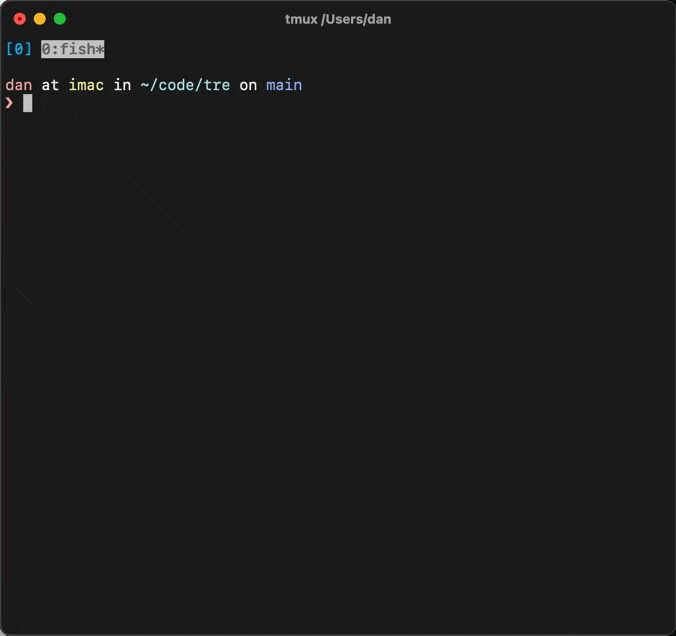4 releases
| 0.4.0 | Jun 19, 2022 |
|---|---|
| 0.3.6 | Mar 27, 2021 |
| 0.3.5 |
|
| 0.3.4 | Feb 21, 2021 |
| 0.3.3 | Nov 17, 2020 |
#1838 in Command line utilities
49 downloads per month
43KB
981 lines
tre
A modern alternative to the tree command that:
- lists directory structure in a tree-like diagram, like the classics.
- skips ignored files in git repositories per
.gitignoresetting. - creates shell aliases for each listing that opens the files for you.
- output in colors, respecting LS_COLORS settings when they exist.
Command aliasing demo:

… in case you missed it: [8] is shown in front of "README.md" and typing e8
opened the file! See how to set this up.
Install
Via a package manager
Tre is available in the following package managers.
| Manager / OS | Command |
|---|---|
| Homebrew / macOS | brew install tre-command |
| MacPorts / macOS | port install tre-tree |
| Debian (testing) | apt install tre-command |
| Scoop / Windows | scoop install tre-command |
| Cargo | cargo install tre-command |
| AUR / Arch Linux | yay -S tre-command |
| pkgsrc / NetBSD 9.1+ | pkgin install tre-command |
| Nixpkgs / NixOS | Use tre-command |
| Nix flake | Use github:dduan/tre |
The commands above are basic instructions. Use your favorite alternatives if you have one. For example, use a config file for Nix; or other method to install from AUR; pkgsrc can be use on OSes other than NetBSD etc.
Pre-built executable
Choose an pre-built executable from the release page that fits your platform to download. Unpack it somewhere you'd like to run it from.
From Source
- Clone this repository:
git clone https://github.com/dduan/tre.git. - Ensure you have Rust and Cargo installed. If not, follow instruction here.
- In the root level of this repo, run
cargo build --release. - Move
target/release/treto somewhere in your PATH environment variable.
Editor aliasing
tre provides a -e flag that, when used, turns on the "editor aliasing"
feature. Some shell configuration will make this work better.
macOS/Linux
By default, the environment variable $EDITOR is used as the editor. If a
value following -e is supplied (tre -e emacs instead of tre -e), then
the command specified by this value will be used instead of $EDITOR. Update
the script in the next section accordingly.
Bash or Zsh
In ~/.bashrc or ~/.zshrc (for example)
tre() { command tre "$@" -e && source "/tmp/tre_aliases_$USER" 2>/dev/null; }
Fish
Create ~/.config/fish/functions/tre.fish:
function tre
command tre $argv -e; and source /tmp/tre_aliases_$USER ^/dev/null
end
Windows (10+)
Instead of directly executing tre.exe, we'll set up a script that's
available in your PATH environment variable. For example, you can add
\Users\yourname\bin to your PATH environment variable, and created the
script there. When you use tre, this script executes tre.exe, and do some
additional work. The content of the script is different for PowerShell and
Command Prompt.
By default, the default program known by Windows will be used to open the
file. If a value following -e is supplied (tre -e notepad.exe instead of
tre -e), then the command specified by this value will be used. Update the
scripts in the next section accordingly.
PowerShell
Add a tre.ps1 file:
if (Get-Module PSReadLine) {
Remove-Module -Force PSReadLine
}
tre.exe $args -e
. $Env:TEMP\tre_aliases_$env:USERNAME.ps1
Command Prompt (CMD.exe)
Add a tre.bat:
@echo off
tre.exe %* -e
call %TEMP%\tre_aliases_%USERNAME%.bat
How it works
The first thing you'll notice is some numbers in front of each file name in
tre's output. If pick a number, say, "3", and enter e3 in the shell, the file
after "3" will open in your default program (specified by the environment
variable EDITOR in macOS/Linux, and picked by Windows).
Everytime tre runs with -e, it updates a file in a temporary directory, and
adds an alias for each result it displays. And the additional configuration
simply sources this file after the command. You can manually run
in Bash/Zsh/Fish:
source /tmp/tre_aliases_$USER
or
in PowerShell
. $Env:TEMP\tre_aliases_$env:USERNAME.ps1
or
in Command Prompt
call %TEMP%\tre_aliases_%USERNAME%.bat
… instead of configuring your system (if you are that patient!).
Everything else
Here's the output from tre -h, showing all available options provided by tre:
USAGE:
tre [OPTIONS] [PATH]
ARGS:
<PATH> [default: .]
OPTIONS:
-a, --all Print all files and directories, including hidden ones
-c, --color <WHEN> When to color the output. `automatic` means when printing to a
terminal, tre will include colors; otherwise it will disable colors
[default: automatic] [possible values: automatic, always, never]
-d, --directories Only list directories in output
-e, --editor [<COMMAND>] Create aliases for each displayed result, and add a number in front
of file name to indicate the alias name. For example, a number "42"
means an shell alias "e42" has been created. Running "e42" will
cause the associated file or directory to be open with $EDITOR (or a
default program for the file type on Windows), or a command
specified along with this command
-E, --exclude <PATTERN> Exclude paths matching a regex pattern. Repeatable
-h, --help Print help information
-j, --json Output JSON instead of tree diagram
-l, --limit <LIMIT> Limit depth of the tree in output
-p, --portable Generate portable (absolute) paths for editor aliases. By default,
aliases use relative paths for better performance
-s, --simple Use normal print despite gitignore settings. '-a' has higher
priority
-V, --version Print version information
If you like the editor aliasing feature, you may want to check out ea.
Packaging
tre is a standard Cargo-managed Rust project.
A unix manual is available at manual/tre.1.
Completion scripts for various shells are at scripts/completion.
License
MIT. See LICENSE.md.
Dependencies
~6–15MB
~173K SLoC